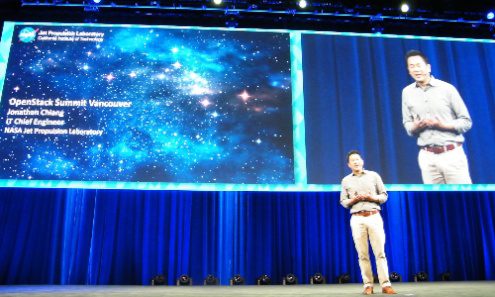VANCOUVER, BC – OpenStack’s Nova compute project originally began as the Nebula project at NASA. At the OpenStack conference here, Jonathan Chiang, IT Chief Engineer at NASA JPL detailed how the space agency is now using OpenStack in its effort to land humans on Mars. “NASA is a place where we dare mighty things,” Chiang […]
Datamation content and product recommendations are
editorially independent. We may make money when you click on links
to our partners.
Learn More
VANCOUVER, BC – OpenStack’s Nova compute project originally began as the Nebula project at NASA. At the OpenStack conference here, Jonathan Chiang, IT Chief Engineer at NASA JPL detailed how the space agency is now using OpenStack in its effort to land humans on Mars.
“NASA is a place where we dare mighty things,” Chiang said.
Cloud Storage and Backup Benefits
Protecting your company’s data is critical. Cloud storage with automated backup is scalable, flexible and provides peace of mind. Cobalt Iron’s enterprise-grade backup and recovery solution is known for its hands-free automation and reliability, at a lower cost. Cloud backup that just works.
SCHEDULE FREE CONSULT/DEMO
Chiang explained that JPL is a leading center for the robotic exploration of the solar system. He noted that there has been a robotic presence on Mars since 1976. Since then an increasingly complex array of spacecraft have landed on Mars.
Chiang also highlighted a number of efforts that NASA has underway as the space agency aims to deliver on President Obama’s mandate to bring humans to the surface of the red planet. One such mission is the Europa Clipper, which is a robotic craft headed to the moons of Jupiter in a search for life. Additionally there is a NASA asteroid redirect mission in the planning stages that will see a spacecraft intercept, retrieve and bring an asteroid to the moon’s orbit where it can be further analyzed and explored.
Overall Chiang emphasized that there is a lot of technology needed to bring humans to Mars and the process to develop all that technology generates lots of data. Chiang said a modern orbiter can generate as much as 80 terabytes of data every day.
The challenge for JPL is that it has a limited financial budget as well as limited data center real estate. Chiang said that the JPL cannot expand its data center’s physical footprint, which is where OpenStack is now playing a key role.
For each mission, JPL needs to figure out capital expenditures before a mission and will often buy hardware in advance to support it. Not all of the hardware is always active, especially in the planning stages, so there is a need to achieve greater operational efficiency from money that has already been spent.
“JPL needs open and free technology to make uses of infrastructure,” Chiang said.

NASA’s Jonathan Chiang
Sean Michael Kerner is a senior editor at Datamation and InternetNews.com. Follow him on Twitter @TechJournalist
Graphic courtesy of Shutterstock.
-
Huawei’s AI Update: Things Are Moving Faster Than We Think
FEATURE | By Rob Enderle,
December 04, 2020
-
Keeping Machine Learning Algorithms Honest in the ‘Ethics-First’ Era
ARTIFICIAL INTELLIGENCE | By Guest Author,
November 18, 2020
-
Key Trends in Chatbots and RPA
FEATURE | By Guest Author,
November 10, 2020
-
Top 10 AIOps Companies
FEATURE | By Samuel Greengard,
November 05, 2020
-
What is Text Analysis?
ARTIFICIAL INTELLIGENCE | By Guest Author,
November 02, 2020
-
How Intel’s Work With Autonomous Cars Could Redefine General Purpose AI
ARTIFICIAL INTELLIGENCE | By Rob Enderle,
October 29, 2020
-
Dell Technologies World: Weaving Together Human And Machine Interaction For AI And Robotics
ARTIFICIAL INTELLIGENCE | By Rob Enderle,
October 23, 2020
-
The Super Moderator, or How IBM Project Debater Could Save Social Media
FEATURE | By Rob Enderle,
October 16, 2020
-
Top 10 Chatbot Platforms
FEATURE | By Cynthia Harvey,
October 07, 2020
-
Finding a Career Path in AI
ARTIFICIAL INTELLIGENCE | By Guest Author,
October 05, 2020
-
CIOs Discuss the Promise of AI and Data Science
FEATURE | By Guest Author,
September 25, 2020
-
Microsoft Is Building An AI Product That Could Predict The Future
FEATURE | By Rob Enderle,
September 25, 2020
-
Top 10 Machine Learning Companies 2020
FEATURE | By Cynthia Harvey,
September 22, 2020
-
NVIDIA and ARM: Massively Changing The AI Landscape
ARTIFICIAL INTELLIGENCE | By Rob Enderle,
September 18, 2020
-
Continuous Intelligence: Expert Discussion [Video and Podcast]
ARTIFICIAL INTELLIGENCE | By James Maguire,
September 14, 2020
-
Artificial Intelligence: Governance and Ethics [Video]
ARTIFICIAL INTELLIGENCE | By James Maguire,
September 13, 2020
-
IBM Watson At The US Open: Showcasing The Power Of A Mature Enterprise-Class AI
FEATURE | By Rob Enderle,
September 11, 2020
-
Artificial Intelligence: Perception vs. Reality
FEATURE | By James Maguire,
September 09, 2020
-
Anticipating The Coming Wave Of AI Enhanced PCs
FEATURE | By Rob Enderle,
September 05, 2020
-
The Critical Nature Of IBM’s NLP (Natural Language Processing) Effort
ARTIFICIAL INTELLIGENCE | By Rob Enderle,
August 14, 2020
SEE ALL
CLOUD ARTICLES
SMK
Sean Michael Kerner is an Internet consultant, strategist, and contributor to several leading IT business web sites.








